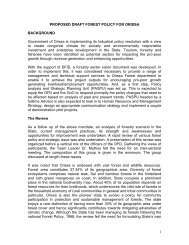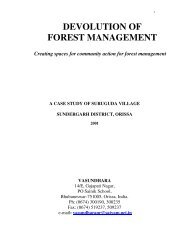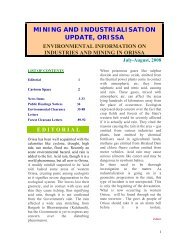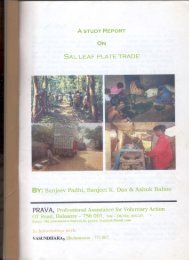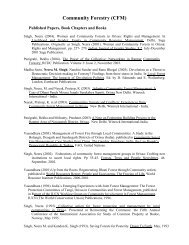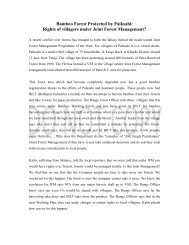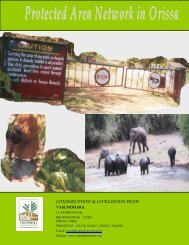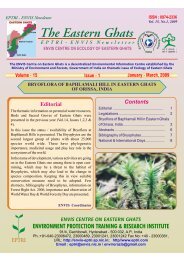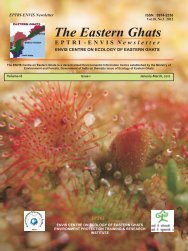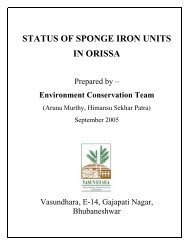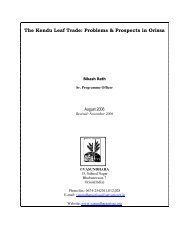Bamboo in Orissa: Trade and Livelihood Perspective - Vasundhara
Bamboo in Orissa: Trade and Livelihood Perspective - Vasundhara
Bamboo in Orissa: Trade and Livelihood Perspective - Vasundhara
You also want an ePaper? Increase the reach of your titles
YUMPU automatically turns print PDFs into web optimized ePapers that Google loves.
All rights reserved by VASUNDHARA(www.vasundharaorissa.org). For any clarification, contact author at sunlit1968@yahoo.co.<strong>in</strong><br />
A lot of cane used to be available from private wastel<strong>and</strong>s or jungles <strong>in</strong> the coastal districts<br />
(like at Bhedab<strong>and</strong>h, Belagadia, Balis<strong>in</strong>ga <strong>and</strong> Jiala <strong>in</strong> the Kakatpur-Konark region of Puri<br />
district). However, these resources have been badly affected due to utilisation of the<br />
wastel<strong>and</strong>s for cultivation, plantation (of commercial species of timber trees) or other<br />
purposes. The super cyclone of 1999 also damaged some resource.<br />
The impact of <strong>in</strong>creas<strong>in</strong>g scarcity of the raw material <strong>and</strong> the restriction imposed by the<br />
govt has left the cane artisans <strong>in</strong> lurch. Transit is risky even if brought from private l<strong>and</strong>s,<br />
because the forest officials can not be conv<strong>in</strong>ced always; <strong>and</strong> some growers have not<br />
agreed to give it <strong>in</strong> writ<strong>in</strong>g that it was collected from their l<strong>and</strong>. Usually cane work is<br />
considered superior to bamboo work <strong>and</strong> a caste known as betara pana used to deal <strong>in</strong><br />
only this 42 . Another reason for avoid<strong>in</strong>g bamboo work by the betara community was that<br />
bamboo work often needs a rough h<strong>and</strong>l<strong>in</strong>g whereas cane work is comparatively delicate,<br />
hence the skill of the h<strong>and</strong> may be affected if a cane-worker concentrates simultaneously<br />
on bamboo also. Pana is a scheduled caste community, but the difference between betara<br />
pana <strong>and</strong> other pana is that the latter are professional drum-beaters often <strong>in</strong>vited <strong>in</strong> festive<br />
occasions <strong>and</strong> hence they can depend both on bamboo work <strong>and</strong> drum-beat<strong>in</strong>g, whereas the<br />
betara pana consider drum-beat<strong>in</strong>g a derogatory work. However, acute scarcity has forced<br />
some of them to try their h<strong>and</strong> either on bamboo (as one can f<strong>in</strong>d at Belabani near<br />
Nayagarh) or some other substitute like kia(P<strong>and</strong>anus spp.) stem(as <strong>in</strong> Nilakanthapur<br />
village near Charishri, Puri district). The betaras of Belabani were known as Raj-betara i.e.,<br />
cane(beta <strong>in</strong> local language) workers <strong>in</strong> the service of the K<strong>in</strong>g; but almost all of them have<br />
ab<strong>and</strong>oned cane work s<strong>in</strong>ce long, particularly after availability of the raw material <strong>in</strong> the<br />
local area(like Sulia forest) was drastically reduced which forced them to switch over to<br />
bamboo work permanently. In all such areas visited by us, one th<strong>in</strong>g was common that they<br />
themselves never tried to conserve <strong>and</strong>/or propagate the resource. Even at Nilakanthapur,<br />
the artisans have probably only one cane clump left <strong>in</strong> the nearest wastel<strong>and</strong>, but no body is<br />
try<strong>in</strong>g to conserve the same. There is no coord<strong>in</strong>ation among the artisans on this issue <strong>and</strong><br />
everybody just considers that it is his right to exploit the available resource at the time of<br />
need irrespective of the threat status of the resource.<br />
Varieties<br />
Artisans of Belabani dist<strong>in</strong>guish the follow<strong>in</strong>g varieties of cane:<br />
Variety<br />
Characteristic<br />
Katha(kabari) beta Most preferred <strong>and</strong> commonly used for cane-work<br />
Gauri(banambara) beta Very difficult to work; not used.<br />
(Calamus latifolius)<br />
Sauri beta<br />
Not used by artisans; the sticks(lathi) used by<br />
policemen can be made from it.<br />
Pani beta(Cuttack cane or Found near water bodies(streams); less preferred<br />
C.fasciculatus)<br />
than kabari beta, but used particularly because the<br />
products assume a reddish colour. Less durable.<br />
42 Exceptions are said to exist, like <strong>in</strong> Kakatpur area some dama <strong>and</strong> bauri caste people are also said to be<br />
practic<strong>in</strong>g cane work. Good market dem<strong>and</strong> of the product probably encouraged them <strong>in</strong> this l<strong>in</strong>e.<br />
95



